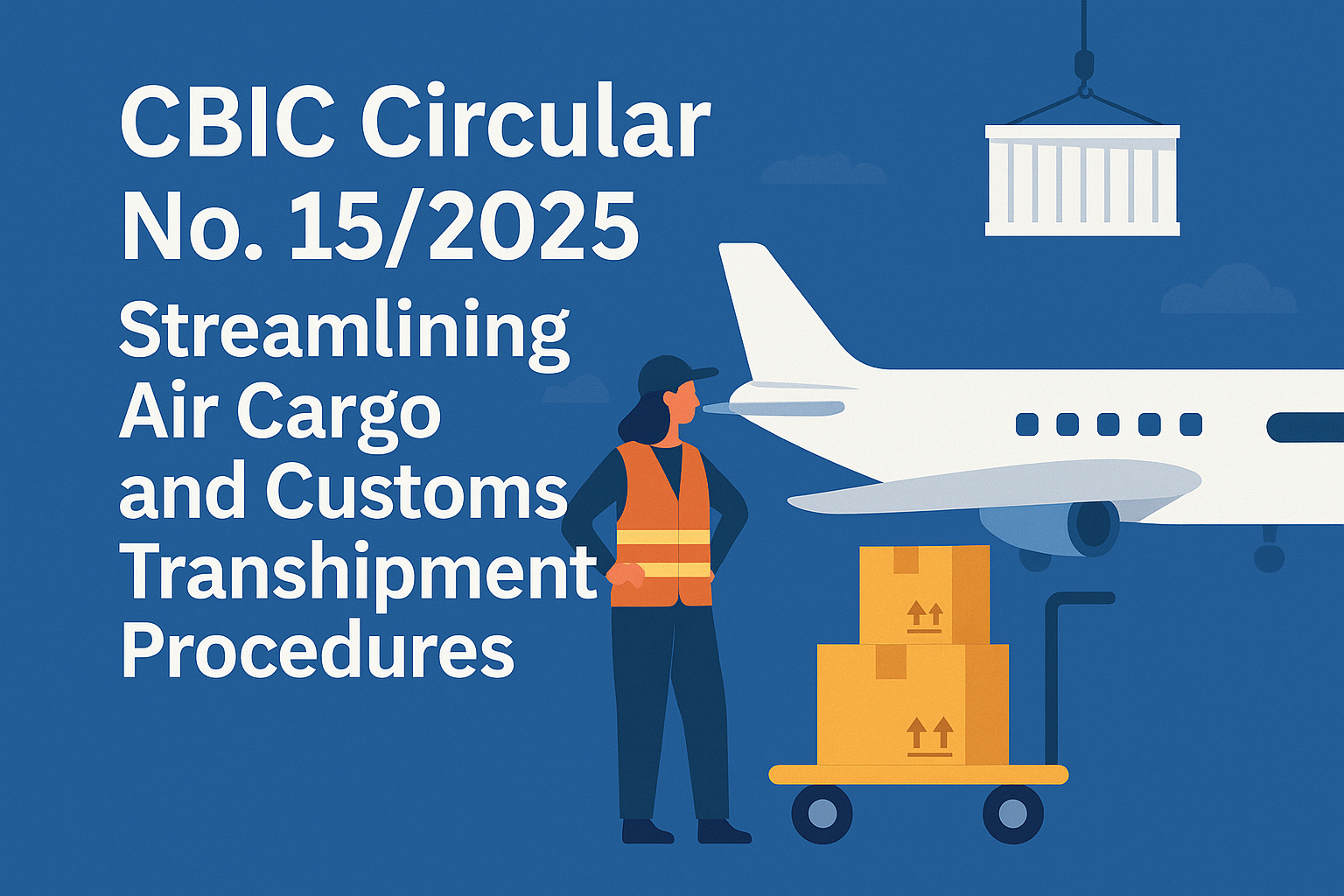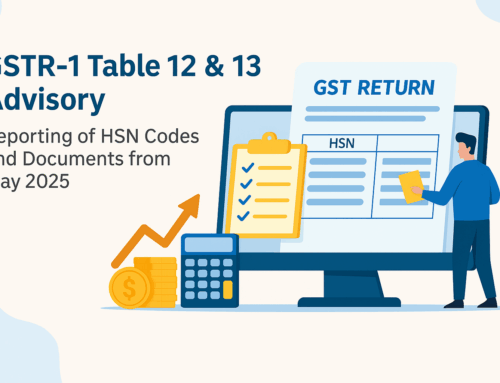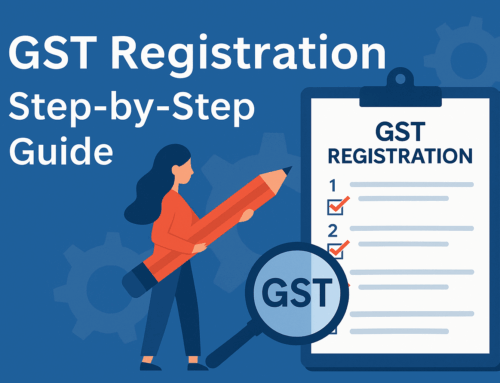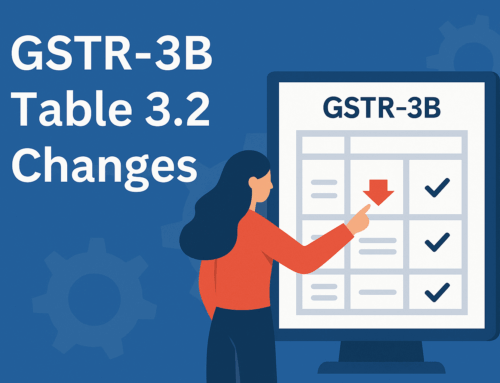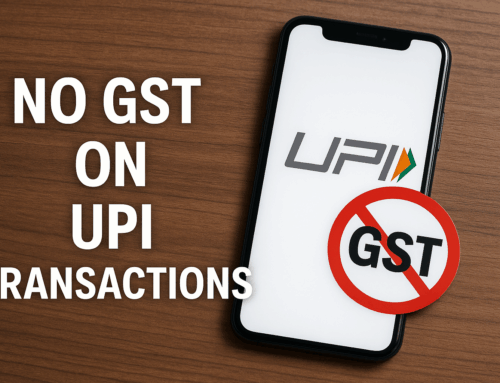Streamlining Air Cargo and Customs Transhipment Procedures: CBIC Circular No. 15/2025
Introduction
On April 25, 2025, the Central Board of Indirect Taxes and Customs (CBIC) issued Circular No. 15/2025, introducing significant reforms for simplifying and streamlining air cargo movement and customs transhipment procedures. Aimed at enhancing trade facilitation, these changes align with the 2025–26 Union Budget’s focus on improving logistics infrastructure and supporting perishable exports. For Chartered Accountants, tax practitioners, and customs brokers, this circular is critical for ensuring compliance and operational efficiency. This blog provides an in-depth analysis of the reforms, their implications, and practical steps for adaptation for streamlining air cargo.
Key Reforms and Implications for Streamlining Air Cargo and Customs Transhipment Procedures
India’s air cargo sector, vital for high-value and time-sensitive goods like pharmaceuticals and horticulture produce, has long required streamlined customs processes to meet global standards. Circular No. 15/2025 addresses this need by eliminating redundant fees, standardizing Unit Load Device (ULD) procedures, reaffirming the National Transhipment Bond System, and advancing digitalization through ICEGATE. Below, we explore each reform in detail, highlighting background, impact, and procedural requirements for streamlining air cargo and customs transhipment procedures.
1. Abolition of ₹20 Transhipment Permit Fee
Background: Under the Goods Imported (Conditions of Transshipment) Regulations, 1995, a ₹20 fee was charged per transhipment permit, creating a recurring cost for logistics operators.
Reform: Notification No. 30/2025-Customs (N.T.), dated April 24, 2025, abolished this fee, effective immediately.
Impact: This waiver reduces operational expenses, particularly for high-volume operators, and accelerates documentation at transhipment points, enhancing clearance efficiency.
Procedure: Update internal systems to eliminate fee payments for transhipment permits post-April 24, 2025.
Practical Tip: Verify with customs authorities to ensure compliance with the updated fee structure to avoid overpayments.
2. Standardized Unit Load Device (ULD) Procedures
Background: ULDs, essential for consolidating air cargo, were previously restricted to customs areas, complicating the handling of perishable goods. This reform aligns ULD procedures with international standards and marine container protocols outlined in Circular No. 31/2005-Customs.
Reform Details:
- The ULDs/air containers without any tracking devices or those along with tracking devices already affixed on the container can be imported temporarily outside the customs area on execution of a “Continuity Bond” by the air carriers/air console agents.
- Tracking devices on ULDs must have a Unique Identity Number (UIN) and comply with Bureau of Civil Aviation Security (BCAS) regulations, including Aircraft and Airport Physical Security Guidelines.
- Proof of export must be submitted within the prescribed period, though the exact timeline remains unspecified in the circular.
- Standalone tracking devices not affixed to ULDs are not exempt under Notification No. 104/94-Customs and may incur duties.
Impact: This facilitates faster handling of time-sensitive cargo, reducing delays, but introduces new compliance requirements for documentation and security.
Procedure:
- Execute a Continuity Bond for temporary ULD imports.
- Ensure tracking devices are BCAS-compliant and registered with a UIN.
- Maintain records for proof of export submission.
Practical Challenge: BCAS compliance may require additional verification, potentially causing initial delays. Stakeholders should prioritize training to meet these standards.
Note:- Standalone tracking devices may incur duties under Notification No. 104/94-Customs.
3. National Transshipment Bond System
Background: Introduced in 2022, the All-India National Transhipment Bond allows a single bond for transhipment across all customs stations, reducing the need for multiple local bonds.
Reform: The circular reaffirms this system, encouraging wider adoption to simplify operations.
Impact: This reduces administrative burdens, particularly for operators working across multiple ports, and enhances operational flexibility.
Procedure: Adopt the All-India bond for transhipment activities, ensuring compliance with existing guidelines.
Practical Tip: Advise clients to transition to this system for streamlined documentation and cost savings.
4. ICEGATE Digitalization for Transshipment Requests
Background: Manual filing of transhipment requests often led to delays and errors, hindering efficiency.
Reform: The circular enables online filing of transhipment requests through the ICEGATE portal, the customs electronic data interchange gateway.
Impact: This digitization reduces turnaround times, minimizes manual intervention, and provides centralized access for carriers and agents, aligning with global digital trade trends.
Procedure: File all transhipment requests via ICEGATE, ensuring staff are trained to navigate the platform.
Practical Tip: Invest in ICEGATE training to avoid technical issues and maximize efficiency.
Key Implications for Stakeholders
- Airlines and Console Agents: Benefit from cost reductions and streamlined ULD handling, improving cargo movement efficiency.
- Customs Brokers and CHA Agents: Gain from fee waivers and digital filing, simplifying client services.
- Importers/Exporters: Experience faster clearances and lower costs, enhancing competitiveness, especially for perishable goods.
Note on Deadlines and Penalties: The circular does not specify explicit deadlines or penalties, but failure to submit proof of export for ULDs within the prescribed period may attract customs scrutiny or duties, as per standard regulations.
Summary Table of Reforms
| Reform Area | Key Details | Impact |
|---|---|---|
| Transhipment Permit Fee | Waived ₹20 fee from April 24, 2025, via Notification No. 30/2025-Cus (N.T.) | This reduces administrative burdens and improves clearance efficiency. |
| ULD Import Compliance | Temporary import with Continuity Bond, UIN, BCAS compliance, proof of export | Enhances efficiency, requires new compliance measures |
| National Transhipment Bond | Single bond since 2022, reaffirmed for all customs stations | Simplifies documentation, reduces administrative burden |
| ICEGATE Integration | Online filing of transhipment requests is enabled | Improves turnaround time, reduces manual processes. ICEGATE eliminates the need for visiting service centers at air cargo terminals. |
Conclusion
CBIC Circular No. 15/2025 is a progressive step toward modernizing and streamlining air cargo and transhipment framework, aligning with global trade facilitation standards set by the World Customs Organization. By eliminating fees, standardizing ULD procedures, and promoting digitalization, it reduces costs and enhances efficiency. Tax professionals and customs brokers must adapt to these changes, ensuring compliance and leveraging digital tools to stay competitive in a dynamic trade environment.
An important resource for Streamlining Air Cargo and Customs Transshipment Procedures:-
Circular No. 15/2025-Customs :- Simplification of procedures related to Air Cargo Movement & Transhipment -reg.
How TaxPower GST Can Help
While Circular No. 15/2025 focuses on customs, tax professionals must manage both customs and GST compliance seamlessly. TaxPower GST does not directly help with Streamlining Air Cargo and Customs Transhipment Procedures. However, it does support Tax Professionals and
TaxPower GST offers a robust platform for automating GSTR-1, GSTR-3B, e-invoicing, and multi-client account management. With real-time updates on law changes, it helps you stay compliant. This lets you focus on customs advice and improves efficiency for your practice or business.
Get one month free trial :-
For expert GST automation and compliance support, contact TaxPower GST:
- Phone: +91 7219789783 / +91 7219789784 / +91 9604971357
- Email: sales@virajsoftsolutions.com
- Website: https://taxpowergst.com
Disclaimer:-
This blog is intended for informational purposes only and should not be considered legal or financial advice. Readers are encouraged to independently verify all applicable GST laws, regulations, CBIC advisories, GSTN guidelines, and E-Way Bill rules before making decisions. The author and publisher are not responsible for any actions taken based on the information provided here.
